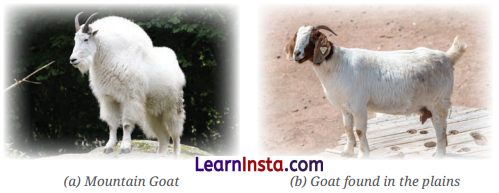Diversity in the Living World Class 6 Questions and Answers NCERT Solutions
Class 6 Science Chapter 2 Diversity in the Living World Question Answer
Let Us Enhance Our Learning
Question 1.
Here are two types of seeds. What differences do you find among the roots and leaf venation of their plants?

Answer:
Differences between wheat and kidney beans:
| Features | Wheat (Monocot) | Kidney Beans (Dicots) |
| (i) Root system | Fibrous root system | Taproot system |
| (ii) Root characteristics | Dense network of thin roots | Central thick taproot with lateral branches |
| (iii) Leaf venation | Parallel venation | Reticulate venation , |
| (iv) Leaf venation characteristics. | Veins run parallel along the length of the leaf. | Network of branching veins with a permanent midrib. |
Question 2.
Names of some animals are given below. Group them based on their habitats. Write the names of aquatic animals in the area marked. ‘ A ‘ and terrestrial animals in area marked ‘B’. Enter the names of animals living in both habitats in part ‘C’.
Horse, Dolphin, Frog, Sheer Crocodile, Squirrel, Whale, Earthworm, Pigeon, Tortoise.

Answer:
‘A’ Aquatic animals: Dolphin, Tortoise.
‘B’ Terrestrial animals: Horse, Sheep, Squirrel, Earthworm, Pigeon.
‘C’ Animals living in both habitats : Frog, crocodile, whale.
Question 3.
Manu’s mother maintains a kitchen garden. One day, she was digging out radish from the soil. She told Manu that radish is a kind of root. Examine a radish and write what type of root it is. What type of venation would you observe in the leaves of radish plant?
Answer:
Radish has a tap root system. The type of venation observed in the leaves of radish plant is reticulate venation.
![]()
Question 4.
Look at the image of a mountain goat and a goat found in the plains. Point out the similarities and differences between them. What are the reasons for these differences?

Answer:
Similarities: They both have four legs, two horns and one tail and their bodies are covered with fur.
Differences: In comparison to goats found in the plains, mountain goats have woolly fur, a hump on the shoulders and cloven hooves. Their legs are relatively shorter than the legs of goats found in the plains.
The difference in these features arise due to the difference in the climate of the habitats. Mountain goats are adapted to survive in extreme cold conditions while goats found in the plains are adapted to survive in the plains.
Question 5.
Group the following animals into two groups based on any feature other than those discussed in the chapter— cow, cockroach, pigeon, bat, tortoise, whale, fish; grasshopper, lizard.
Answer:
(i) Flying Animals:
(a) Pigeon
(b) Bat
(c) Cockroach
(d) Grasshopper
(ii) Non-flying Animals:
(a) Cow
(b) Tortoise
(c) Whale
(d) Fish
(e) Lizard
Question 6.
As the population grows and people want more comfortable lives, forests, are being cut down to meet various needs. How can this affect our surroundings? How do you think we can address this challenge
Answer:
Consequences of Cutting trees :
- Damage to wild life.
- Increased air pollution.
- Imbalance between the oxygen-carbon dioxide cycle in the atmosphere.
- Lesser rain fall.
We can address this challenge by adopting following method:
- More trees should be planted in the forest in place of cut down trees.
- Paper products (such as old newspapers) should be recycled to conserve forests.
Question 7.
Analyse the flowchart. What can be examples of ‘ A ‘ and ‘ B ‘?

Answer:
A: Hibiscus leaves
B: Banana plants
![]()
Question 8.
Raj argues with his friend Sanjay that “Gudhal (hibiscus) plant is a shrub”. What questions can Sanjay ask for clarification?
Answer:
Sanjay can ask the following questions:
What is the height of Gudhal plant?
Does it bear a thin and woody stem?
Are the branches close to the ground?
Question 9.
Based on the information in the table, find out examples of these plants for each group.

(a) What other similarity do plants of group A have?
(b) What other similarity do plants of group B have?
Answer:
Examples for group A and B.
1. Rose, mango, radish, carrot and hibiscus
2. Grass, wheat, onions, maize and rice etc.
(a) Similarity of Plants in Group
A: Plants in Group A (dicots) typically have leaves with reticulate venation.
(b) Similarity of Plants in Group
B: Plants in Group B (monocots) generally have leaves with parallel venation.
Question 10.
Observe the labelled part of a duck in the picture given below. What differences do you observe in the feet of the duck compared to the other birds? Which activity would the duck be able to perform using this part?
Answer:

Their webbed feet help them to swim in water. Duck have webbed feet other birds have two pairs of limbs. The forelimbs are modified into wings for flight. The hind limbs alone support the body.